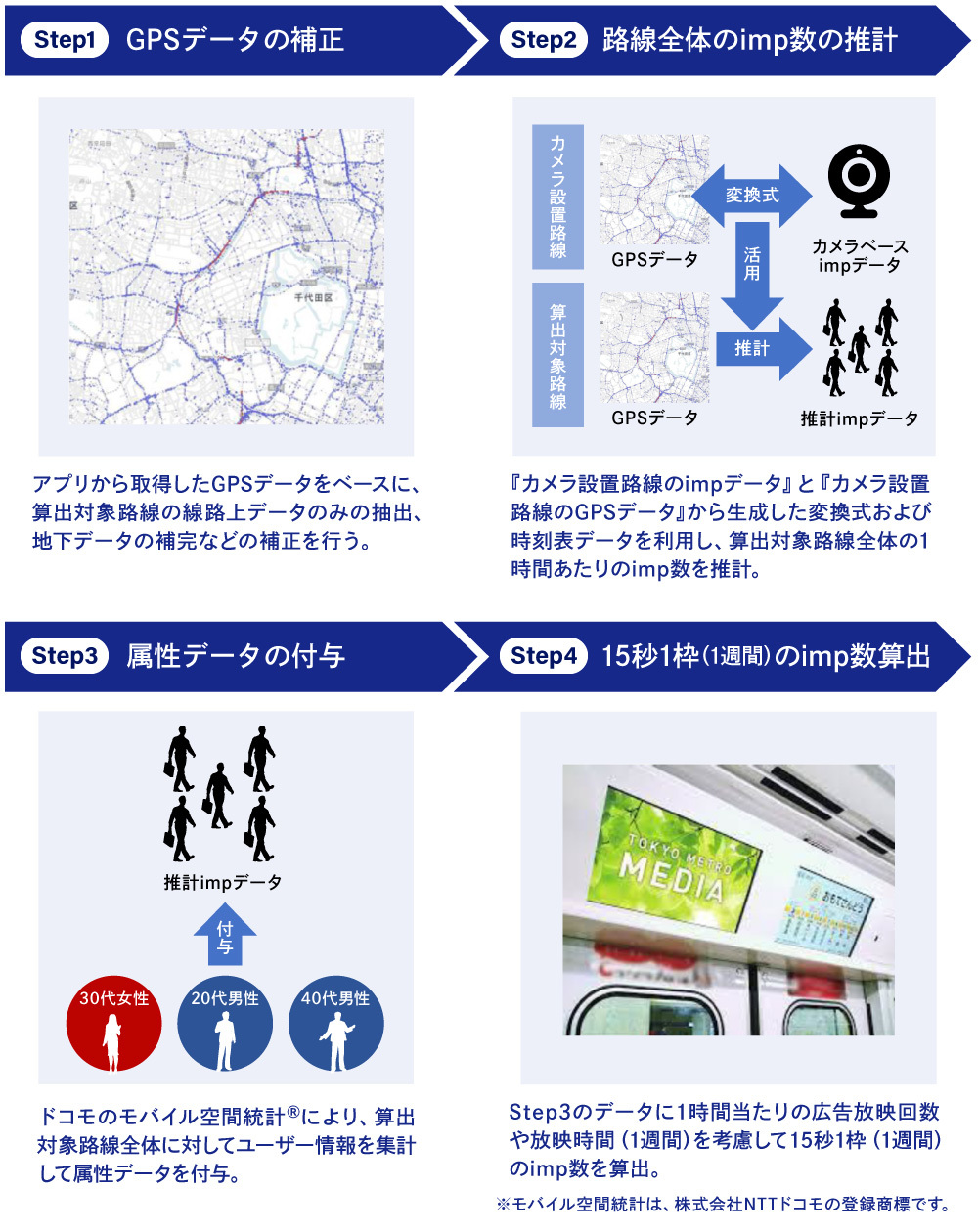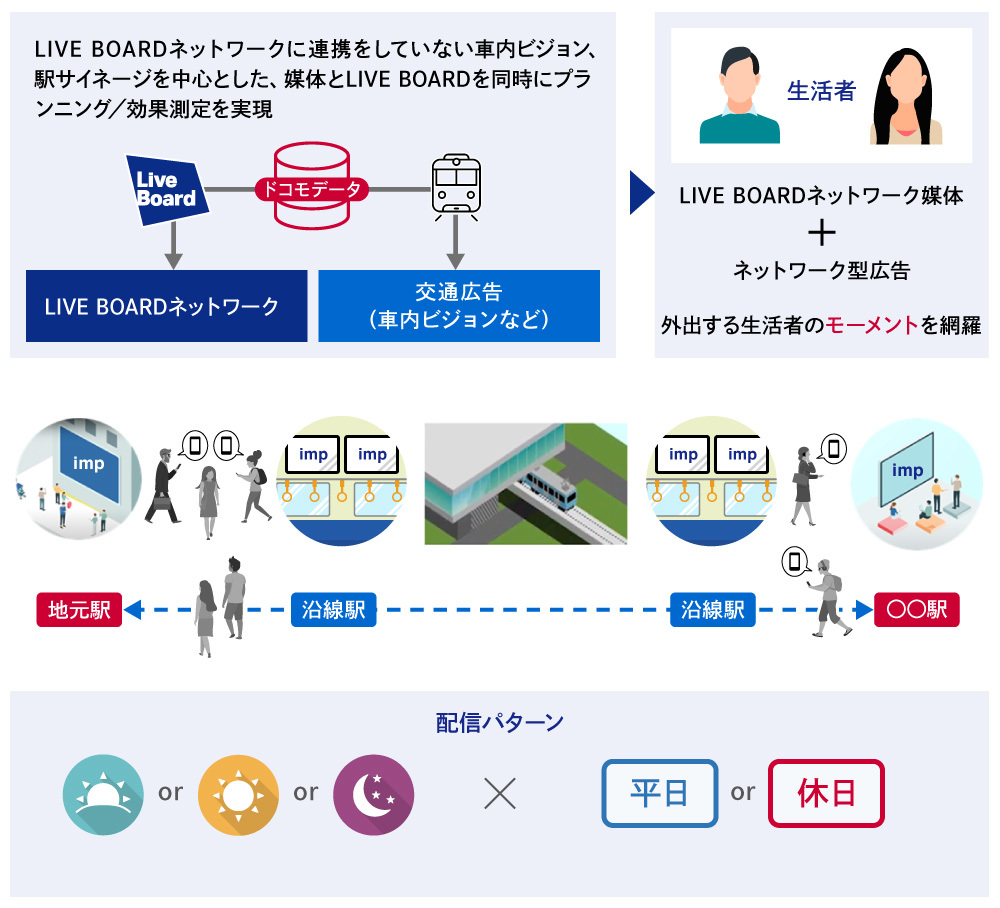"Visualizing the Effectiveness of All OOH Advertising!" ~The Future Envisioned by New Standard~
"We primarily advertise on TV and the internet, but we're considering other media too."
"But we're reluctant to invest in advertising where we can't measure the effectiveness."
"Is there a medium that can target and reach audiences like internet advertising does?"
We receive many such inquiries, and we recognize that establishing "a medium that enables effectiveness visualization, following television and the internet" has become a common challenge for clients.
To address these challenges, "LIVE BOARD," the next-generation digital OOH (Digital Out of Home, hereafter DOOH), was born.
【LIVE BOARD Inc.】
A joint venture company established in 2019 by NTT DOCOMO and Dentsu Inc. Pioneered Japan's first impression-based (ad viewership) delivery in the OOH space. Even under conditions prone to changes in foot traffic, like the COVID-19 pandemic, it delivers ads and operates a billing system based on the number of people assumed to see "that ad, at that time, in that place," achieving delivery and billing that closely align with reality. Furthermore, by combining its unique network—which spans diverse DOOH locations nationwide, including outdoor and indoor spaces, train interiors, and station concourses—with big data from Japan's largest carriers, it enables people-centric delivery. This includes targeting by gender and age group, something traditionally difficult in OOH. LIVE BOARD owns this networked DOOH infrastructure across Japan.
Details here
https://dentsu-ho.com/articles/7958
Furthermore, by launching the "New Standard" initiative—which leverages LIVE BOARD technology to measure the effectiveness of OOH advertising beyond the LIVE BOARD network—OOH advertising has evolved into a medium where effectiveness can be visualized.
In this article, Hirotaka Manou of Dentsu Inc. OOH introduces the future of OOH business enabled by "New Standard."
The Background of "New Standard"
LIVE BOARD's ability to enable planning, purchasing, and verification based on impressions has earned high praise from many clients. Even as the overall OOH market contracted during the COVID-19 pandemic, LIVE BOARD steadily increased its sales.
However, at its inception, LIVE BOARD's primary focus was "outdoor media." Clients expressed the desire: "If only we could purchase and verify transit media impressions the same way we do with LIVE BOARD." The "New Standard" project was launched to address this demand.
Leveraging NTT DOCOMO's technology, we measure impressions on in-vehicle displays. By quantifying the number of ad viewers, we can now verify advertising effectiveness and ROI alongside LIVE BOARD.
However, the goal of the "New Standard" project isn't merely "measuring in-vehicle vision." It aims to bring about a major transformation in the entire OOH business by visualizing the value of all OOH advertising, not just in-vehicle vision, through impressions and presenting quantitative value standards.
Over the past decade, the evolution of digital media has shifted advertising value evaluation from "slot" to "person." Yet, OOH advertising evaluation remains largely defined by circulation (how many people can potentially be reached) – a "slot"-based metric.
The "New Standard" aims to completely reframe the value of OOH advertising from a "space" perspective to a "person" perspective. Achieving this should allow OOH to align with television and the internet in establishing accountability for advertising spend. We believe this will position OOH as "a medium that can visualize effectiveness, following television and the internet," enabling greater utilization by clients.
"How do you measure in-vehicle vision?"
The impression measurement for in-vehicle vision under "New Standard" is divided into four main steps.
① Extract data from routes included in the calculation based on GPS data obtained from the app
② Multiply the ad visibility rate from the LIVE BOARD network (Saitama Rapid Railway's in-vehicle vision) by the data from step ① to estimate hourly impressions for the entire target route
③ Attribute data is assigned to the entire target route using Docomo's Mobile Spatial Statistics®
④ Calculate the impressions per ad slot by considering the number of ad airings per hour and the airing period for the data from step ③

By leveraging NTT DOCOMO's GPS data and viewership data from camera-equipped routes within the LIVE BOARD network (Saitama Rapid Railway), we have achieved measurement of in-vehicle vision viewership with unprecedented accuracy—a feat previously considered impossible (data is collected with personal information protected).
In March 2022, we conducted impression measurement for Tokyo Metro's "Tokyo Metro Vision" and developed a bundled product combining LIVE BOARD outdoor advertising with in-vehicle vision. Furthermore, in July 2022, we enabled time-slot-specific delivery for "Tokyo Metro Vision".
Whereas in-car vision could previously only run continuously throughout the day, LIVE BOARD now allows targeted delivery only during the most effective times for the desired audience. For example, ads can be shown only during weekday mornings when the percentage of male viewers in their 30s is high.

Categories (Days): ① Weekdays (Mon-Fri) ② Holidays (Sat-Sun)
Category (Time Slot): ① Morning (0:00–9:00, first train departure) ② Daytime (10:00–17:00) ③ Evening (18:00–23:00)
Delivery Patterns: ① Weekday Morning ② Weekday Afternoon ③ Weekday Evening ④ Holiday Morning ⑤ Holiday Afternoon ⑥ Holiday Evening (6 patterns total)
※The above 6 patterns can be combined with LIVE BOARD display surfaces for utilization.
How will communication evolve with "New Standard"?
Not only does it measure in-vehicle vision impressions, but by enabling time-based distribution of in-vehicle vision content, OOH communication itself has undergone significant evolution.
For example, a B2B company utilized Tokyo Metro Vision's time-based distribution to address the challenge of "building brand awareness among students in the Kanto region."
They delivered content via in-car vision during the "weekday morning" and "weekend evening" time slots, which have a high concentration of 20-somethings. Simultaneously, they utilized outdoor/station vision within a 250m radius of universities during daytime hours (10:00-18:00).
This approach efficiently captured the target audience's moments: engaging them via in-train screens during their commute and via outdoor screens during daytime activities near their universities.
This approach of "efficiently capturing every moment of consumers' outdoor lives" is now possible thanks to the ability to schedule in-train screen content by time slot, making it a valuable tool for various clients.
For example, for beer, where drinking intent peaks at night, we could deliver in-train visuals only on weekday and weekend evenings, while using outdoor advertising only near convenience stores to maximize the recency effect (the effect where ads seen immediately before influence consumer purchasing activity).
For skincare products targeting skin concerns, in-vehicle vision could be delivered during the morning hours when consumers are most conscious of their skin, while outdoor advertising could be limited to sunny days when sunlight is strongest. By separating the delivery timing of in-vehicle vision and outdoor advertising, it becomes possible to capture the most effective moments based on consumers' actual behaviors.
This enhanced precision benefits both clients and consumers. For consumers, OOH is a medium that creates "chance encounters" with products/services. By increasing precision, these chance encounters with products/services that consumers are more interested in become more likely.
OOH, now capable of measuring effectiveness, is becoming an advertising medium on par with TV and internet advertising.
The "New Standard" project is currently implementing two initiatives to enable more clients to utilize LIVE BOARD.
The first is network expansion. We are advancing impression measurement and distribution integration not only with "Tokyo Metro Vision" but also with various in-vehicle vision systems, aiming to capture moments for more consumers. By advancing distribution integration, the number of unique users (UU) LIVE BOARD can reach will increase. We consider this a crucial initiative for enhancing LIVE BOARD's value as a reach medium following television and the internet.
Second is the advancement of effectiveness verification. Currently, we verify the differences in awareness among individuals who have been exposed to both in-vehicle vision and outdoor advertising, primarily based on asking surveys. However, we plan to enable verification utilizing actual behavioral logs in the future.
By tracking outdoor and in-vehicle ad exposure at the individual ID level, clients in industries like food service and retail can verify whether exposure led to actual purchases or store visits. Clients in services or gaming can verify whether exposure led to app downloads, launches, or visits to their company websites.
Furthermore, it enables more aligned, side-by-side effectiveness verification with TV and internet, such as identifying behavioral changes among individuals exposed to multiple channels and measuring LIVE BOARD's contribution toward targeted KPIs.
Through the "New Standard" project, we aim to transform the entire OOH business and solve clients' communication challenges by providing quantitative metrics for all OOH advertising.
For more on OOH, we also recommend the following series:
・Proven! The "Societal Impact Effect" Generated by OOH
・The New Normal for OOH
Was this article helpful?
Newsletter registration is here
We select and publish important news every day
For inquiries about this article
Author

Hirotaka Manou
Dentsu Inc.
After nine years of experience in planning within the promotion/marketing field at the Chubu Branch Office, I joined the Out-of-Home Media Division. In addition to formulating marketing/sales strategies for LIVE BOARD, I am engaged in advancing DOOH planning and effectiveness verification centered on "people."

